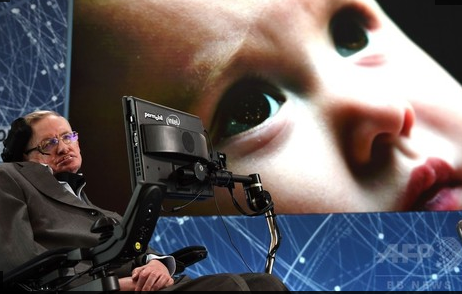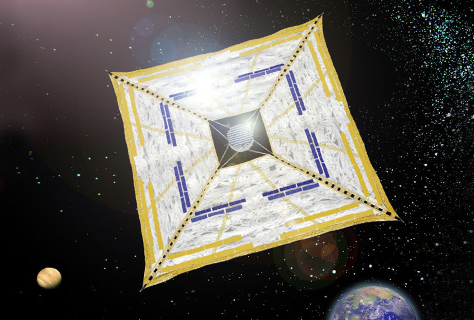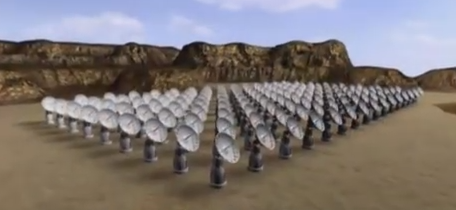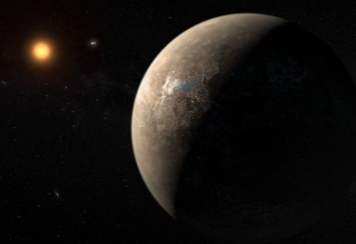64-1 The Wall of Time
At a rate of traditional space ship it takes
・5 months to Mars. [1](It takes 2.6 years to round trip due to the revolution of the Earth and Mars.)
・20 to 30 years to out of Solar System
・30,000 years to go to our nearest neighbouring star, Alpha Centauri (distance: four light years). [1]
⇒Human colonization of other planets will be achieved by intelligent machines consisting of mechanical and electronic components.- Stephen William Hawking

⇒If humans are required, it will be reproduced from the DNA information. [2]
※Maximum speed of the vehicle, which was invented by human is 111km / s in the Apollo 10. [3]
64-2 A New System:Laser-Powered Engine
:Propulsion of spacecraft is obtained by irradiation of the laser to the sail. (Use of Solar wind is also possible)
:The system can propel spacecraft to 30% of lightspeed. [1]
:This could get a 100 kilogram robotic craft to Mars in three days.( A craft occupied by humans would take slightly longer -- but at a month.) [1]
○Tasks:
・Energy source
・It is necessary to install the base on the planet orbit.
・There is a need also to set up a base on the arrival point for deceleration.
※Lightspeed=300,000km / s
○Development status of laser propulsion system
1973-1975 Mariner 10(USA) which flew by the planets Mercury and Venus demonstrated the use of solar pressure as a method ofattitude control in order to conserve attitude-control propellant. [4] [5]
2010 Japan Aerospace Exploration Agency (JAXA) launched the world's first interplanetary solar sail spacecraft"IKAROS" (Interplanetary Kite-craft Accelerated by Radiation Of the Sun) to Venus. [4]
2015 Light Sail-A (The Planetary Society) was successfully tested to deploy a solar sail.
2016 The Team of Stephen Hawking and Yuri Milner proposed making a journey to Alpha Centauri.(⇒No.64-5 Breakthough Starshot)

※IKAROS== Interplanetary Kite-craft Accelerated by Radiation Of the Sun(JAXA)
64-3 Antimatter Spaceship [6]
・Causing the "annihilation" of positrons and electrons to get the driving force of the spacecraft.
・Expected to be 40% of the speed of light.
・10 years to go to our nearest neighbouring star, Alpha Centauri (distance: about 4 light years).
○Problems
・To save antimatter is not possible with current technology (1g antimatter is the same destructive power as an atomic bomb).
・The anti-hydrogen required for the journey towards the nearest star is about 17g, but the cost of making the antimatter 1g is about 1,000 billion$.
64-4 Planet Type Spacecraft
○For long-term space travel of humans, we must have Planet type spacecrafts.
※ Planet type spacecraft;PTS:Which is a Spacecraft Modified a Planet for ultra-long-term space travel.
64-5 Plans to Build Interstellar Spacecraft:Breakthough Starshot [7]
○April 2016 The Team of Stephen Hawking and Yuri Milner proposed making a journey to Alpha Centauri.
○The craft(Nanocraft) will have a solar sail, a few meters across and weighing a few grams.
○And the craft will reach 20% of the speed of light within 10 minutes—fast enough to reach Alpha Centauri(distance: about 4 light years) in 20 years.
※Nanocraft:The spacecraft (dubbed a StarChip), would be a very small centimeter-sized vehicle weighing a few grams. The camera, computer, communications laser, a plutonium power source, photon thrusters and the solar sail (4 by 4 meters) must be miniaturized to fit within a mass limit. They would be propelled by a square-kilometre array of 10 kW ground-based lasers with a combined output of up to 100 GW. [8]

※StarChip + Lightsail:Nanocraft [9]

※StarChip [10]
※Weight:1g。
○All components must be engineered to endure extreme acceleration, cold, vacuum, and protons.
○The team calculates the laser technology will be ready in a few decades’ time. (Energy source is nuclear fusion.(⇒No.66 Fusion Power))
○ In this plan, the spacecraft will cross Alpha Centaurs in a few minutes. [10]
○ The cost is $ 10 billion.

※レーザー推進システム [9]
○By the way, Alpha Centauri is to close to 3 light-years after approximately 25,000 years .
64-6 Level of Space Travel
Level1 Rocket
Level2 Spaceship Earth ⇒No.71-2 Move the Earth = Spaceship Earth
Level3 Starship ⇒No.79 Starship
Level4 Transporter
Level5 Warp ⇒No.81 Black holes are exits to the another universe?
【References】
1. Nasa's laser-powered engine could get us to Mars in 72 hours
http://www.wired.co.uk/news/archive/2016-02/22/laser-propulsion-system-mars-in-3-days
2. No.39 Brain
3. Un kickstarter per sviluppare il motore ad antimateria(ITALIA)
http://www.wired.it/scienza/spazio/2016/03/03/kickstarter-per-sviluppare-motore-ad-antimateria/
4. Solar sails (also called light sails or photon sails) - Wikipedia
https://en.wikipedia.org/wiki/Solar_sail
5. Mariner 10
http://solarviews.com/eng/marin10.htm
6. New and Improved Antimatter Spaceship for Mars Missions
http://www.nasa.gov/centers/goddard/news/topstory/2006/antimatter_spaceship.html
7. Science News
http://www.sciencemag.org/news/2016/04/russian-billionaire-unveils-big-plan-build-tiny-interstellar-spacecraft
8. Breakthrough Starshot - Wikipedia
9. LIVE: Stephen Hawking and Yuri Milner to announce space exploration initiative “Starshot”
https://www.youtube.com/watch?v=c7VPHGjT8A4
10. Will Starshot's Insterstellar Journey Succeed?
https://www.youtube.com/watch?v=fsARBnvUB2E
【Change log】
20170522 Addition of materials to No.64-5 Plans to Build Interstellar Spacecraft:Breakthough Starshot

